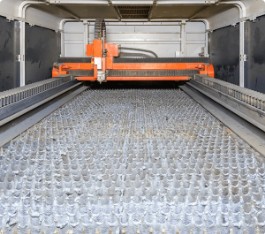Hidden Costs of Ultra-High-Power Fiber Lasers: Table Slat Cleaning
Hidden Costs of Ultra-High-Power Fiber Lasers: Table Slat Cleaning
Ultra-high-power fiber lasers open new possibilities for cutting thick metal — but they also bring hidden operational costs. One of the most underestimated issues is slag build-up on table slats, which can halt automation and raise maintenance expenses.
In this article, we explain how to properly maintain and replace slats, which materials to choose, and what operational strategies help extend the lifespan of cutting tables and equipment.
The Rise of Ultra-Powerful Lasers
Over the past few years, fiber lasers in the 30–50 kW range have completely changed expectations in metal processing.
Where oxy-fuel and plasma systems once dominated for cutting 25–40 mm plates, today’s high-power lasers achieve superior results with greater precision, speed, and flexibility.
However, this progress comes with a challenge: rapid slag accumulation on the supporting slats. These deposits are not a minor inconvenience — they directly impact productivity, automation reliability, and long-term cost of ownership.
Why Slat Condition Matters
During high-power laser cutting, molten metal is expelled at high velocity.
Unlike oxy-fuel slag — which is porous and brittle — nitrogen and mixed-gas cutting produce solidified, dense crusts that bond to the slat surface. Over time, these deposits can cause severe operational issues.
A typical scenario:
A cutting cycle finishes, and the automated forks attempt to remove a sheet. But the metal has welded itself to the support grid.
The system lifts the entire section — slats and all — leading to machine stoppage and costly downtime.
In many cases, the cost of lost production exceeds the cost of maintenance.
Table 1. Slag Characteristics by Assist Gas
| Assist Gas | Slag Type | Ease of Cleaning |
|---|---|---|
| Oxygen | Porous, brittle | Easy |
| Nitrogen | Dense, sticky | Difficult |
| Nitrogen + Oxygen | Very solid | Very difficult |
| Dry Air | Similar to N₂+O₂ | Very difficult |
Slag Accumulation Zones
Slag tends to form in three key areas:
-
In the valley of the slat tooth
-
On the side surface
-
On the tooth tip
Excess build-up on the tips can cause sheet misalignment and height detection errors. Even with modern “sawtooth” designs, the problem cannot be completely eliminated.
The longer maintenance is delayed, the higher the risk of permanent bonding and slat deformation.
Practical Maintenance Strategies
1. Cutting Path Analysis
Modern CAM software allows visualization of support grids. Adjusting the nesting pattern to avoid cutting directly over slats can significantly reduce slag adhesion.
2. Selective Slat Removal
For thick or heavy parts, removing certain slats can minimize contact and prevent molten material from welding to the supports.
3. Rotation and Repositioning
Regularly rotating front and back sections of the slat table ensures even wear and longer service life.
4. Slug Destruction Mode
Many CNC systems offer a slug-destruct option, breaking loose cutouts into smaller pieces to ensure they drop cleanly.
5. Minimizing Contact Points
Fewer contact areas mean less back-side contamination and smoother part surfaces.
Table 2. Material Thickness vs. Slat Strategy
| Material Thickness | Recommended Strategy |
|---|---|
| ≤1.5 mm | Dense slat grid, no removal |
| 2–6 mm | Regular rotation, moderate slat removal |
| 8–20 mm | Slug destruction, fewer contacts |
| >20 mm | Partial slat removal, deep gaps |
Design and Material Considerations
Copper Slats
With higher thermal conductivity, copper retains less heat — meaning less slag adhesion and easier cleaning.
Tooth Geometry
Thin sheets benefit from dense tooth spacing, while thick plates require robust profiles with deeper valleys.
Slat Thickness
As laser power increases, standard 3 mm slats are often replaced by 4.5–6 mm variants for durability.
Specialized Shapes
Some designs use serpentine or cross inserts to reduce slag build-up. These are effective but costlier and harder to produce independently.
Table 3. Slat Material Comparison
| Material | Advantages | Disadvantages |
|---|---|---|
| Steel | Affordable, easy to source | Heavy slag adhesion |
| Copper | Easy to clean, less slag | High cost |
| Alloys | Balanced properties | Limited availability |
Maintenance and Replacement
Even the best-designed slats degrade without proper care.
Cleaning — Modern cleaning units use multi-blade rotary cutters set at an angle to efficiently remove hardened slag.
Frequency — Once per week for standard operation; daily for thick steel cutting in multi-shift environments.
Protective Coatings — Applying anti-adhesive coatings slows slag formation.
Replacement — Regular inspection and scheduled replacement prevent dimensional errors and machine crashes.
Some workshops increase tooth height by 3–6 mm to extend lifespan, but ultimately, planned replacement is unavoidable.
Conclusion
Ultra-high-power lasers deliver unmatched performance in metal processing — yet their efficiency depends on disciplined maintenance.
Proper slat cleaning, use of heat-conductive materials like copper, optimized nesting strategies, and software automation all contribute to longer uptime and consistent cut quality.
Neglecting maintenance can lead to costly downtime, damage, and compromised precision.
That’s why at UDBU, we emphasize not only innovation in laser technology but also the practical knowledge that keeps production reliable, efficient, and profitable.

